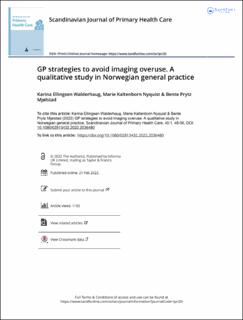| dc.contributor.author | Walderhaug, Karina Ellingsen | |
| dc.contributor.author | Nyquist, Marie Kaltenborn | |
| dc.contributor.author | Mjølstad, Bente Prytz | |
| dc.date.accessioned | 2023-03-06T12:04:17Z | |
| dc.date.available | 2023-03-06T12:04:17Z | |
| dc.date.created | 2022-05-02T14:44:14Z | |
| dc.date.issued | 2022 | |
| dc.identifier.citation | Scandinavian Journal of Primary Health Care. 2022, 48-56. | en_US |
| dc.identifier.issn | 0281-3432 | |
| dc.identifier.uri | https://hdl.handle.net/11250/3056023 | |
| dc.description.abstract | Objectives
The aim of the study was to identify general practitioners’ (GPs) strategies to avoid unnecessary diagnostic imaging when encountering patients with such expectations and to explore how patients experience these strategies.
Design, setting and subjects
We conducted a qualitative study that combined observations of consultations and interviews with GPs and patients. A total of 24 patients visiting nine different GPs in two Norwegian urban areas were included in the study. Of these, 12 consultations were considered suitable for studying GP strategies and were therefore selected for a more thorough analysis.
Main outcome measures
GPs’ communication strategies to avoid unnecessary medical imaging and patients’ experiences with such strategies.
Results
Five categories of strategies were identified: (1) wait and see – or suggest an alternative; (2) the art of rejection; (3) seek support from a professional authority; (4) partnership and shared decision-making and (5) reassurance, normalisation and recognition. The GPs often used multiple strategies. Factors related to a long-term doctor–patient relationship seemed to influence both communication and how both parties experienced the decision. Three important factors were evident: the patient trusted the doctor, the doctor knew the patient’s medical history and the doctor knew the patient as a person. The patients seemed to be generally satisfied with the outcomes of the consultations.
Conclusion
GPs largely combine different strategies when meeting patients’ expectations of diagnostic imaging that are not strictly medically indicated. Continuity of the doctor–patient relationship with good personal knowledge and trust between doctor and patient appeared crucial for patients to accept the doctors' decisions. | en_US |
| dc.language.iso | eng | en_US |
| dc.publisher | Informa UK Limited | en_US |
| dc.rights | Navngivelse 4.0 Internasjonal | * |
| dc.rights.uri | http://creativecommons.org/licenses/by/4.0/deed.no | * |
| dc.title | GP strategies to avoid imaging overuse. A qualitative study in Norwegian general practice | en_US |
| dc.title.alternative | GP strategies to avoid imaging overuse. A qualitative study in Norwegian general practice | en_US |
| dc.type | Peer reviewed | en_US |
| dc.type | Journal article | en_US |
| dc.description.version | publishedVersion | en_US |
| dc.source.pagenumber | 48-56 | en_US |
| dc.source.volume | 40 | en_US |
| dc.source.journal | Scandinavian Journal of Primary Health Care | en_US |
| dc.source.issue | 1 | en_US |
| dc.identifier.doi | 10.1080/02813432.2022.2036480 | |
| dc.identifier.cristin | 2020747 | |
| cristin.ispublished | true | |
| cristin.fulltext | original | |
| cristin.qualitycode | 1 | |

